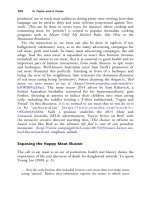The palgrave international handbook of a 345
Bạn đang xem bản rút gọn của tài liệu. Xem và tải ngay bản đầy đủ của tài liệu tại đây (28.01 KB, 1 trang )
Animal Fighting
343
animal fighting (and indeed wider still as part of animal protection
statutes), with no standard data collection requirements or procedures.
Characteristics of Dog Fighting
Many of the characteristics of dog fighting can be revealed by discussing
the Michael Vick case in more detail. Vick and his fellow dog fighters
were breeding, training, selling and fighting dogs over a number of years
and were suspected to be connected to the uppermost elite network of dog
fighters in the USA. Their Badd Newz Kennels was a major operation
involving extensive land, outbuildings, training equipment, illegal veterinary supplies and a total of nearly 60 dogs, all housed on site (Strouse
2009, pp. 23–28).
Only a small number of dogs in the Vick case were euthanised for their injuries
or their extreme aggression, most required specialist evaluation, rehabilitation and
care. The scale of the case and the money involved were actually of benefit in this
regard as it encouraged the court to reserve nearly $1million in escrow to be used
for the ongoing care of the dogs. This would be unusual, if unheard of, elsewhere
in the world. Indeed, in the UK if a pit bull, the same breed of dog as in the Vick
case, is seized as part of a successfully prosecuted dog fighting case, the law will
require it to be euthanised as it is of a prohibited type under the Dangerous Dogs
Act (1991) and ownership is only allowed under very strict conditions.
There are many online and non-academic texts describing the finite detail—
from the terminology to the rules—of dog fighting, its essence though is
defined by Evans et al. (1998, p. 827) as ‘the act of baiting two dogs against
one another for entertainment or gain. It involves placing two dogs in a pit
until one either quits or dies’. A pit of enclosed low walls, perhaps up to a
metre high, will span a space of no more than four to six metres. Dogs will be
weighed before a fight to ensure parity, and handlers may be allowed to wash
their opponent’s dog to ensure no subterfuge in the form of a toxic substance
has been placed on the dog’s coat to harm or inhibit the other dog (Gibson
2005). Those who directly handle the dogs and are permitted to enter the ring
in the USA are referred to as ‘dogmen’ by Forsyth and Evans (1998, p. 202), a
term that until recently has been used far less in the UK.
In its most extreme and organised form, dog fights will last until one
dog fails to scratch (charge over their corner ‘scratch line’, into the centre
of the pit to engage with the other dog); jumps out of the pit; dies; or is
declared the winner, which can take anything from just a few minutes up
to a few hours. The losing dog, unless kept for breeding based on its









